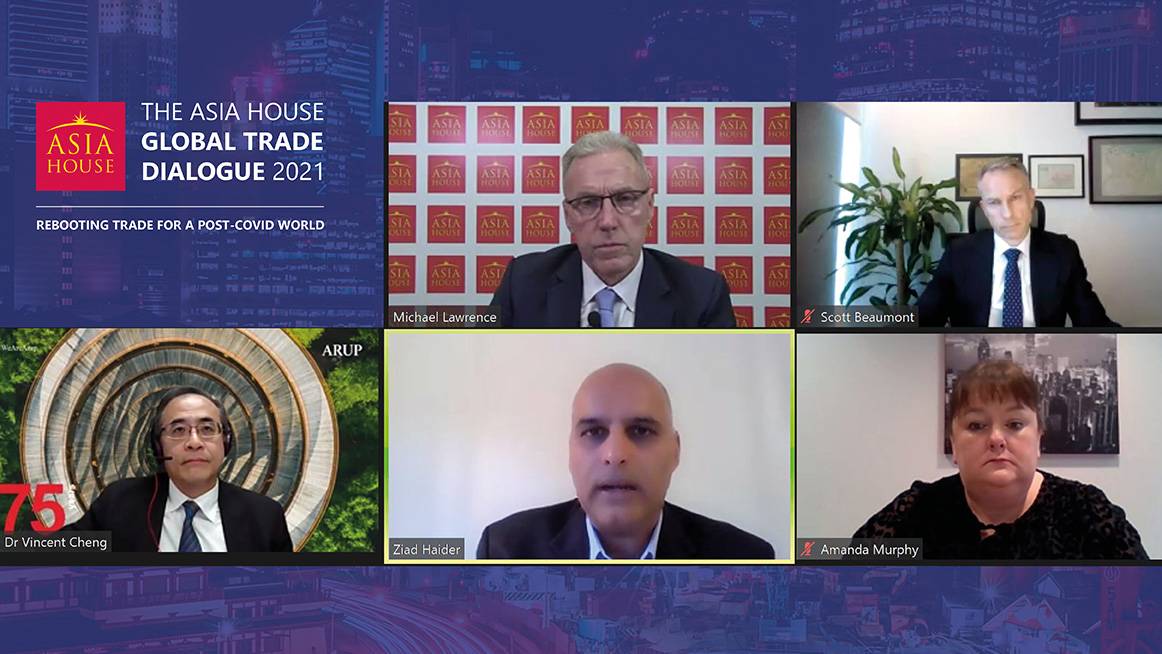Driving commercial and political engagement between Asia, the Middle East and Europe
Driving commercial and political engagement between Asia, the Middle East and Europe
Driving commercial and political engagement between Asia, the Middle East and Europe

Supply chain resilience will continue to present challenges in the Asia-Pacific, but digitalisation and the transition towards a sustainable global economy will bring major opportunities, senior business figures told this year’s Asia House Global Trade Dialogue.
Geopolitical risks, including US-China tensions, need to be factored into corporate plans for 2022, even as firms deal with the consequences and uncertainty of the global pandemic.
Ziad Haider, Head of Political Risk and Director of Risk at McKinsey, outlined some of the challenges facing companies, including the two-year “Phase 1” trade deal between the United States and China in January 2020.
Under the deal, China pledged to increase its purchases of US goods by US$200 billion over the two years. The US Peterson Institute for International Economics, however, has calculated that only 60 per cent of that target had been met by the end of September 2021.
Haider said it was unclear what would happen if China did not meet the target, but warned that it could affect supply chains.
“Companies have to be thinking, and are thinking, about supply chain resilience – for example moving from just-in-time to just-in-case and more onshoring,” he said, adding this nonetheless created opportunities for firms in the region.
Amanda Murphy, HSBC’s Head of Commercial Banking for South and Southeast Asia, said emerging markets, especially in Asia, were growing economically as both producers and consumers.
“This makes them a natural destination for companies that want to build resilience into supply chains,” she said.
Globalisation had changed, Murphy added, though the concept of globalised production had proven “remarkably robust”.
HSBC surveyed more than 3,000 companies in Asia, Murphy said, with the findings suggesting that “supply chains are being reshaped, not reshored, and in the longer term this has the potential to ignite a cycle of self-sustaining growth.”
Scott Beaumont, President of Google Asia Pacific, said companies wanted predictability and certainty about what the rules of trade would be. He said there was no lack of talent in the region. “The issue is not the availability of talent, just the amount of competition there is going to be for that talent.”
Beaumont said digital innovation would be key to the post-COVID recovery and for other challenges, including sustainability.
Vincent Cheng, Climate and Sustainability Services Leader for East Asia at Arup, said that while trade had traditionally been viewed as having a negative impact on sustainability, this was changing.
“Now we see more countries and the business sector trying to decarbonise industry,” he said.
Cheng said four things need to happen to accelerate the drive for sustainability in Asia: the WTO or others need to develop rules to level the playing field; more capital is needed to incentivise markets to develop more green energy or other initiatives to reduce emissions; technology is required – some of which will need to be imported; and, finally, infrastructure needs to be developed.
“From a business perspective, we see some positive signs, we are moving in the right direction, but we need more support and more international input,” Cheng said.
Chaired by Asia House Chief Executive Michael Lawrence, the discussion brought together unique insights from professionals at the heart of global trade.
